|
HISTORY The University of South Florida campus began construction in 1957 on a site adjacent to the north side of Henderson Airfield, and the Busch Gardens theme park was opened in 1959 just south of the airfield. (click buttons to enlarge photos)
|
|
|
A 1959 view looking southwest at Henderson Field, after the Busch Brewery (on the right) had been built over a portion of the former airfield. |
|
|
August A. Busch, Jr. and his son Adolphus Busch IV, dedicate Busch Gardens March 31, 1959 |
|
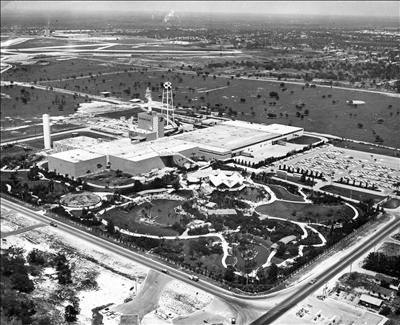 |
A view looking northeast in 1964 |
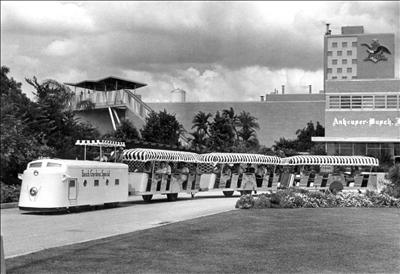 |
The "trackless train" 1964 |
| Back in the fifties, beer-brewer Anheuser - Busch started up a beer garden (with free beer) and a bird show at the front of its new brewery in Tampa. It opened on March 31, 1959 as an admission-free hospitality facility for the Tampa Anheuser-Busch brewery on the grounds of the manufacturing plant. |
|
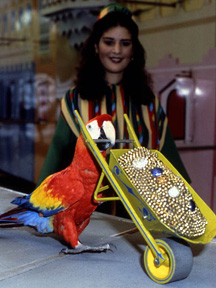 |
Visitors could watch bird shows and animal acts in a tropical setting and before leaving the grounds entered a beer garden offering free Busch beer to drink. Hundreds of exotic birds filled the fully interactive Bird Gardens, all for free admission. |
|
Just as it is today, the birds roamed free, where the guests were free to pet them. Millions visited, and in a stroke of brilliance wildlife-lover August A. Busch Jr. added the 29-acre Serengeti Plains in 1965 (eventually expanded to 70 acres.) The gigantic Serengeti Plain allowed the African wildlife to roam freely and became the largest, free-roaming habitat outside of Africa. It remains one of the most unique features of the park to this day and has received numerous upgrades and expansions.
|
|
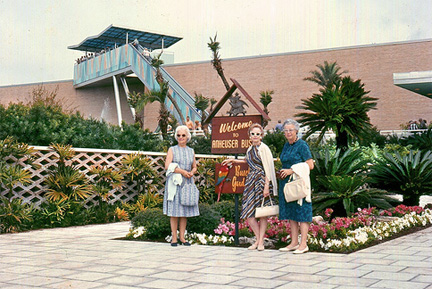 |
What seemed to be the world's longest escalator (known as "the stairway to the stars") rode you to the rooftop where you began the brewery tour. |
|
The "Stairway to the Stars" which led to the brewery tour. Notice the Hospitality House at far left. |
|
|
|
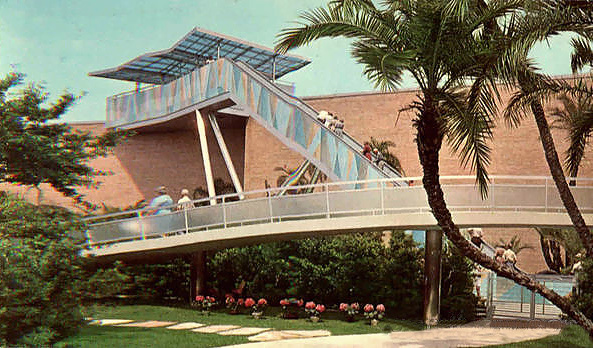 |
The "Stairway to the Stars" which led to the brewery tour. Those who wanted to skip it used the bridge in the foreground. |
|
The enameled panels adorning the side of
the "Stairway to the Stars" escalator at Busch Gardens were produced by
enamel muralist, Paul Hultberg, who was known for his large scale
architectural enamel commissions in copper, steel and aluminum.
Photo and information provided by Lawrence Hultberg, oldest son of the artist, Paul Hultberg. More of his work can be found on this website: www.hultberg.com
|
|
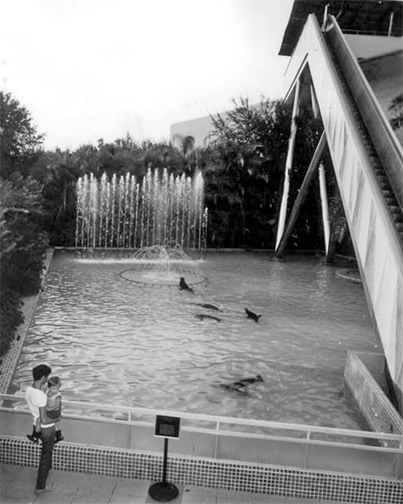
| The Hospitality House offered visitors a place to cool off and sample freshly-brewed Anheuser Busch beers for free. |
|
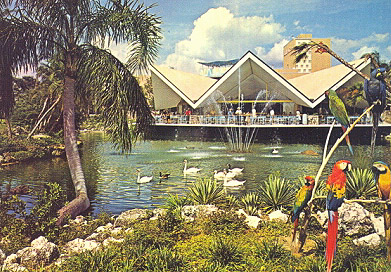 |
The only thing free here now is the air and a seat. |
|
The original section of the park which opened in 1959 for the most part today remains to be mostly gardens, animal exhibits and shows. The traditional, educational bird show was replaced with a newer, more entertainment-based show, including a number of mammals. The popular attraction that once stood in this section was the brewery which closed in 1995. (Gwazi now sits where the brewery was located. ) Land of the Dragons is a children's section filled with scaled down versions of popular thrill rides and a massive tree house playground. The section opened in 1995 and replaced the Dwarf Village, a smaller kids area. See old post cards of the old Fairytale Land. Busch Gardens focused progressively on its tropical landscape, exotic animals, and amusements to draw visitors. Busch Gardens began charging admission as the entertainment became more complex, with extra fees for the thrill rides, such as the roller coasters for which Busch Gardens is now known. |
Original Dwarf Village exhibits
|
| Many came to eat at the Old Swiss House, patterned after the famed Old Swiss House in Lucerne, Switzerland, but overlooking giraffes and gazelles grazing on the Serengeti Plain. Busch had it built in 1964 as a Valentine's Day present for his third wife, Trudy, whose brother owned Switzerland's Old Swiss House. |
|
| Once considered one of the finest restaurants in Tampa, it was closed for seven years, then was renovated and reopened as the Crown Colony House in 1990. | |
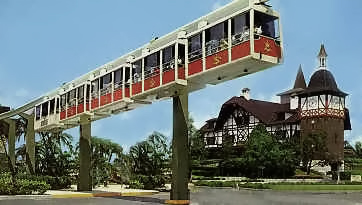 |
The monorail at Busch Gardens opened in 1966. This small suspended system operated boxy trains that used two propane fired, air cooled, aluminum Corvair engines per train to produce the AC power necessary for the electric motors. |
|
The gardens had everything you would expect from a garden, exotic plants, but it also came with exotic animals from far away. One of the park’s earliest sections, Boma, became a zoo of sorts with most of the attractions still residing there today (as the park’s Nairobi section). |
|
|
|
The Busch Gardens Serengeti Express Railroad opened in 1971, becoming the park’s second major ride following the monorail. The train takes guests on a two-mile perimeter ride around the now 335-acre park with stops at the Congo, Stanleyville and Nairobi areas. Along the way, guests on the train ride can see hundreds of African animals on the Serengeti Plain, and other fascinating attractions at the park. The Serengeti Express in 1977 showing its U.S. bicentennial them colors |
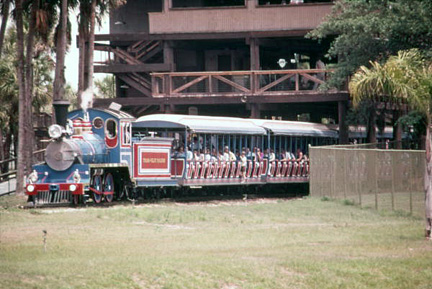
The four locomotive engines are fueled by clean-burning propane gas. Two engines are replicas of the ones used in Africa in the early 1900s, while the remaining two are similar to those used in the American Old West. |
|
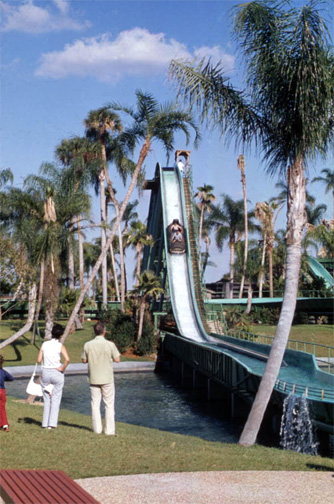 |
The section of the park known as "Stanleyville" opened in 1973 and is home to the park's first water ride, the Stanley Falls Flume. In 1975, Busch added the Moroccan Village, with cafes and Moroccan craftsmen. Acrobats, belly dancers, sword swallowers, magicians and organ grinder monkeys were also featured. The Stanleyville Log Flume, 1973
|
|
In the 70's,
a Sky Ride and more African areas were added and in 1977, the
corkscrew roller coaster, Python, opened. Although lackluster by today's
standards, it was revolutionary at the time.
With the new coaster, Busch also gave the park its second name, Busch Gardens: The Dark Continent. Four years later, the Scorpion, a classic looping roller coaster was added. As was the Python, the Scorpion was a small coaster, but still quite a thrill at the time. Thirteen years passed before Busch Gardens added another roller coaster. Stanleyville's African Queen Boat Ride opened in 1977 as Busch's version of Disney's Jungle Cruise.
|
|
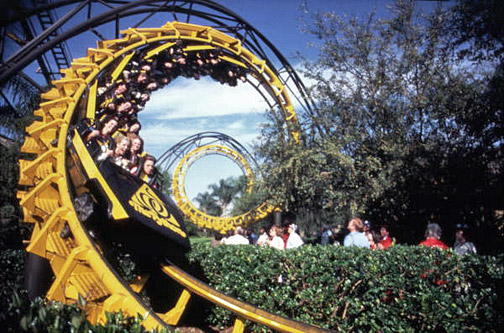
The Python roller coaster, 1976 It was removed in late 2006 when the Congo section began renovations.
The African Queen jungle ride, 1977 |
|
Busch Gardens circa 1978
Special thanks to "Budman" for
these 4 photos
|
|
|
|
Monorail & Sky Buckets |
Hospitality House |
|
|
|
|
Stanleyville Flume ride |
Moroccan village |
|
|
Timbuktu section of Busch Gardens opened in May of 1980 and is themed after the malls and bazaars of Africa. In 1982 the "Congo" section of the park opened with the Congo River Rapids, a water ride that simulates raging whitewater rapids . In 1984 the "Phoenix" was built in Timbuktu and remains a popular ride to this day. Congo River Rapids, 1983 |
|
In 1987 the monorail closed to allow for a complete overhaul of the system, and re-opened in February of 1988. Intamin Inc. of Switzerland built six sleek new trains for the redesigned system. Bus bars retro-fitted to the overhead track provided power for the six car trains. Better air conditioning was aided by deeply tinting the windows on each car. Seventy two passenger trains were capable of six mph, making their round trip in 10 to 12 minutes. |
|
|
In 1989, Stanleyville's African Queen
Boat Ride was transformed into Tanganyika Tidal Wave with the addition of a
55-foot drop that generates a huge splash. The section remained
essentially unchanged until 2005, when SheiKra opened up and the surrounding
area was renovated. In 1992, the Myombe Reserve opened. It is a 3-acre home for six lowland gorillas and nine chimpanzees located in Nairobi.
|
|
|
In 1993, Busch Gardens built their largest coaster yet in any of their parks, the Kumba located in the Congo section. "Kumba," meaning "roar" in an African dialect, is a 143-foot steel sit-down roller coaster with seven inversions. The park continued towards becoming a thrill park with the addition of the inverted roller coaster, Montu, in 1996. Both Montu and Kumba featured completely original design. Many of the elements they introduced have been used on roller coasters elsewhere.
|
|
| On July 2nd 1997, Busch Gardens
opened the Edge of Africa, a new section of the park where guests can walk
through parts of the African veldt and get an up-close view of the animals.
Having just survived a re-alignment to make room for this new section, the
monorail re-opened. For the last few months, it was out of service while
this addition was being constructed. The Veldt Monorail shut down in 1999
due to upkeep cost.
|
|
|
After a quiet period, Busch began more construction in 2003 and 2004. Several areas received refurbishment and the KaTonga show was introduced. Timbuktu was renovated in 2003. Important rides added during this facelift included the Timbuktu Theatre, which replaced the park's Dolphin Theatre with an indoor movie theatre featuring a "4-D" movie about pirates starring Leslie Nielsen. The show replaced the Haunted Lighthouse 4-D attraction written by R. L. Stine. In 2004, the park's family friendly Cheetah Chase roller coaster opened up, replacing the Crazy Camel flat ride. In 2004, the Wilde Maus roller coaster was moved from Williamsburg to Tampa, where it became Cheetah Chase. The biggest addition came in 2005. SheiKra, the tallest and fastest roller coaster in the Southeast and the only dive machine in the United States, opened in May 2005. Beginning November 2006, the "Congo" section underwent major renovation, which included the removal of the park's classic Python roller coaster.
|
|
|
Not only has Busch Gardens been a leader in roller coasters, thrill rides, shows and entertainment, and of course, animals, the park has been a leader in preserving endangered African animals while providing them with replicas of natural habitats. The park is a zoo first and a theme park second; animals take top priority. Busch Gardens has also combined animals into a safari, thrill ride adventure with Rhino Rally. See also: Busch Gardens Timeline summary and How Did Busch Gardens Grow? Over 400 photos of Busch Gardens, mostly from the 1970s, can be seen online at the Florida Memory Project. Do a search for "Busch Gardens" in quotes.
|
|
|
Following the success of Busch
Gardens Tampa, the franchise expanded to two other locations in 1975, opening
parks in Williamsburg, Virginia and Van Nuys, California. The brewery tour in
Van Nuys was amended to include an aviary, a working monorail tour of the
brewery, a log ride, and a boat journey. Sadly, the amusement park didn’t fare
well against other nearby amusement parks and it closed in 1979 to make way for
a brewery expansion.
Busch Gardens Williamsburg (now known
as Busch Gardens Europe) was far more successful, and remains so to this day.
The park is divided into seven areas, each sporting the theme of a European
country. It was voted “Most Beautiful Theme Park in the Country” over a
dozen times, and offers a wide variety of theme park rides and roller coasters,
including Curse of DarKastle, Escape from Pompeii, Alpengeist, Loch Ness
Monster, Apollo's Chariot and Big Bad Wolf. A new roller coaster, Griffon,
will debut at the park in 2007. When completed, it will be the tallest dive
coaster in the world. On November 18, 2008, the combination of InBev and Anheuser-Busch closed, creating Anheuser-Busch InBev, the leading global brewer and one of the top five consumer products companies in the world. SeaWorld and Busch Gardens owner Anheuser-Busch InBev announced that the long tradition of offering free beer samples in their Hospitality Centers and Brewmaster Clubs would come to an end in the parks.Beer will continue to be sold in the parks. Reports speculate that the change was made to make the parks more attractive to buyers. On October 7, 2009 it was announced that Inbev had sold all Busch Properties to The Blackstone Group for $2.7 billion. This sale includes all Busch Entertainment properties. One of the deals in the contract was that the Clydesdales at the parks be removed, as the breed of horse is associated with the Anheuser-Busch brand. In addition, the Busch Entertainment Company division that owned all of the Worlds of Discovery parks (including Busch Gardens) was renamed SeaWorld Parks and Entertainment, officially marking the finalized purchase had succeeded on December 3, 2009.
Photos used on this page were not taken by me; they are from other websites and are used here for non-profit use for the sole purpose of education.
|
|
|
Remember Treasureland across from Busch Gardens? Click image at left
|
|